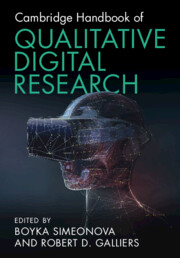Book contents
- Cambridge Handbook of Qualitative Digital Research
- Cambridge Handbook of Qualitative Digital Research
- Copyright page
- Contents
- Figures
- Tables
- Contributors
- Preface
- Part I Philosophical, Epistemological and Theoretical Considerations
- Part II Methodological Considerations
- Part III Illustrative Examples and Emergent Issues
- Chapter 13 Observing Artifacts
- Chapter 14 Algorithms as Co-Researchers
- Chapter 15 Sensemaking about HRV Data of High-Performing Individuals
- Chapter 16 The Rich Facets of Digital Trace Data
- Chapter 17 Balancing the Momentum of Datafication with Qualitative Researchers as Design Thinkers
- Chapter 18 What Data Sharing in Government Tells Us about the Digitalization of Government Services
- Index
- References
Chapter 14 - Algorithms as Co-Researchers
Exploring Meaning and Bias in Qualitative Research
from Part III - Illustrative Examples and Emergent Issues
Published online by Cambridge University Press: 08 June 2023
- Cambridge Handbook of Qualitative Digital Research
- Cambridge Handbook of Qualitative Digital Research
- Copyright page
- Contents
- Figures
- Tables
- Contributors
- Preface
- Part I Philosophical, Epistemological and Theoretical Considerations
- Part II Methodological Considerations
- Part III Illustrative Examples and Emergent Issues
- Chapter 13 Observing Artifacts
- Chapter 14 Algorithms as Co-Researchers
- Chapter 15 Sensemaking about HRV Data of High-Performing Individuals
- Chapter 16 The Rich Facets of Digital Trace Data
- Chapter 17 Balancing the Momentum of Datafication with Qualitative Researchers as Design Thinkers
- Chapter 18 What Data Sharing in Government Tells Us about the Digitalization of Government Services
- Index
- References
Summary
This chapter discusses the reflexive relationship between qualitative researchers and the process of selecting, forming, processing and interpreting data in algorithmic qualitative research. Drawing on Heidegger’s ideas, it argues that such research is necessarily synthetic – even creative – in that these activities inflect, and are in turn inflected by, the data itself. Thus, methodological transparency is key to understanding how different types of meanings become infused in the process of algorithmic qualitative research. While algorithmic research practices provide multiple opportunities for creating transparent meaning, researchers are urged to consider how such practices can also introduce and reinforce human and algorithmic bias in the form of unacknowledged introduction of perspectives into the data. The chapter demonstrates this reflexive dance of meaning and bias using an illustrative case of topic modelling. It closes by offering some recommendations for engaging actively with the domain, considering a multi-disciplinary approach, and adopting complementary methods that could potentially help researchers in fostering transparency and meaning.
Keywords
- Type
- Chapter
- Information
- Cambridge Handbook of Qualitative Digital Research , pp. 211 - 228Publisher: Cambridge University PressPrint publication year: 2023



